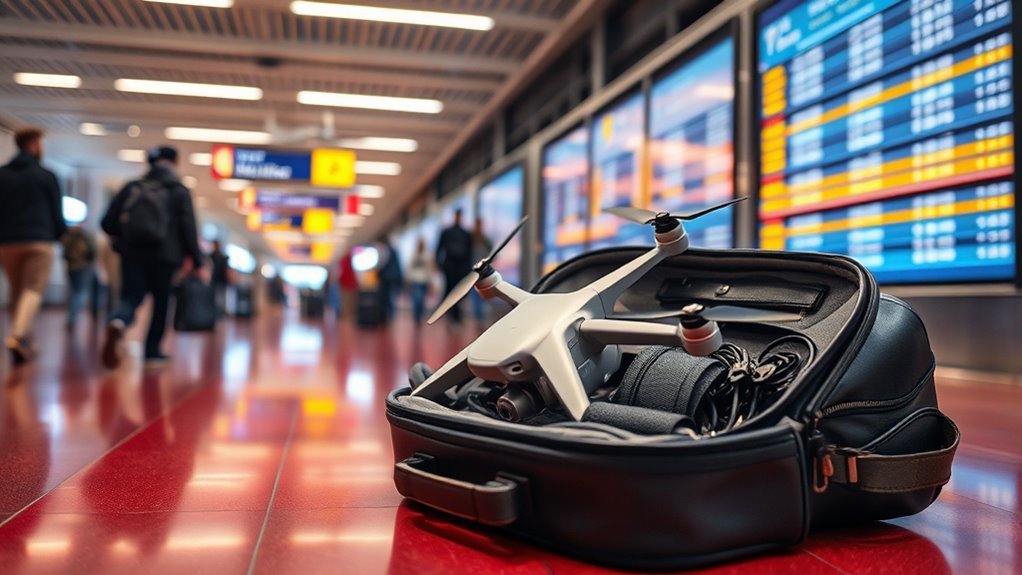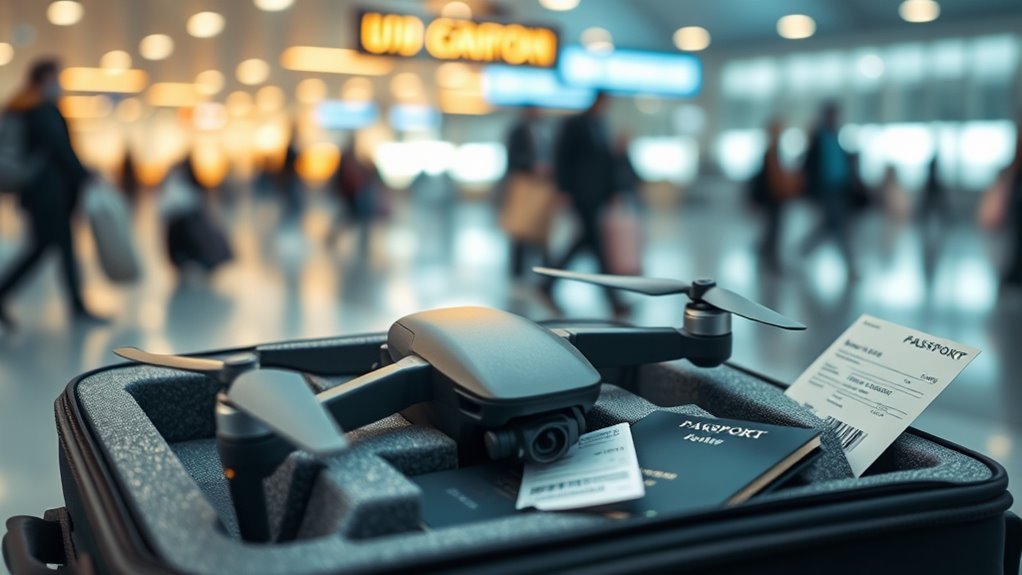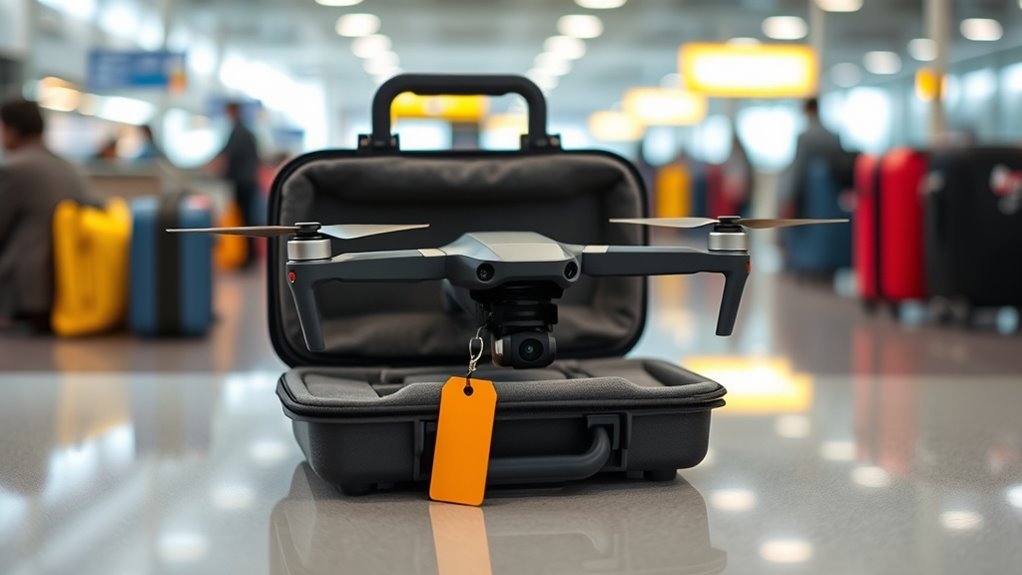To bring a drone on a plane, you need to check specific airline regulations regarding size, weight, and battery restrictions. Remove lithium batteries and carry them in your hand luggage, ensuring they’re within watt-hour limits. Pack your drone securely in a padded case, detaching any loose parts like propellers. At airport security, place the drone in a separate bin for scanning. Familiarize yourself with local drone laws at your destination to avoid issues. You’ll find more tips ahead.
Understanding Airline Regulations for Drones

Before you pack your drone for air travel, it’s crucial to familiarize yourself with the specific airline regulations that govern flying with such devices. Each airline has distinct policies regarding drone specifications, including size, weight, and battery capacity. For instance, many airlines restrict lithium batteries to a certain watt-hour rating, so check your drone’s specs against these limits. Additionally, some airlines may require you to declare your drone during check-in or place it in carry-on luggage. Understanding these policies not only guarantees compliance but also safeguards your freedom to travel with your equipment. Always consult the airline’s website or customer service for the most current information before your trip, as regulations can change frequently.
Preparing Your Drone for Travel

As you prepare your drone for travel, it’s essential to confirm that all components are secure and properly packed to prevent damage during transit. First, check your drone insurance policy to verify you’re covered for any potential mishaps. Next, familiarize yourself with battery regulations specific to your airline; most require that lithium batteries be carried in your carry-on baggage. Remove the batteries from the drone and store them in a protective case. Ascertain that all propellers are detached or secured to avoid movement. Additionally, pack any accessories, like controllers and chargers, in a way that minimizes shifting. By meticulously preparing your drone, you’ll enhance your travel experience and guarantee that you’re ready to capture stunning aerial footage at your destination.
Packing Your Drone: Best Practices

When packing your drone for air travel, it’s essential to follow best practices to guarantee its safety and functionality. Start by confirming proper drone storage; use a padded case that fits snugly. Disassemble any detachable parts to minimize damage risk. Understanding the manufacturing quality controls of your drone can also help you take extra precautions based on its build.
For battery management, keep batteries in their original packaging or a dedicated battery case. Always check airline regulations for lithium-ion batteries to avoid compliance issues. Here’s a quick reference table:
| Item | Action | Notes |
|---|---|---|
| Drone Body | Secure in padded case | Prevents physical damage |
| Propellers | Detach and store separately | Avoid bending or breaking |
| Batteries | Pack in fireproof case | Comply with airline rules |
Following these guidelines confirms your drone travels safely. Additionally, ensure that you are aware of signal attenuation challenges when flying your drone after arrival, as they can affect performance in various environments.
Navigating Security Checks at the Airport
Although security checks can be intimidating, knowing what to expect can make the process smoother. When you arrive at the airport, familiarize yourself with the security procedures involving your drone. Place your drone in a separate bin for scanning, ensuring all batteries are removed and stored properly. Remember, certain components might be considered prohibited items, so check with your airline in advance. Avoid packing spare batteries larger than the allowed watt-hour limit. Keep your drone manual handy; it may help clarify any questions security personnel have. Stay calm, cooperate with staff, and be prepared to answer questions about your drone’s specifications. Adhering to these guidelines will facilitate a hassle-free experience at the security checkpoint.
Arrival at Your Destination: What to Know
What should you keep in mind upon arriving at your destination with a drone? First, check local travel restrictions regarding drone usage. Regulations vary widely, and understanding them prevents legal issues. Next, verify you have appropriate drone insurance; this protects you from potential liabilities or damages. Before launching your drone, assess the area for no-fly zones and environmental considerations. Always respect privacy laws and avoid restricted locations like airports or military bases. Remember that some regions may require permits for drone operation. Additionally, be mindful of the drone registration requirements to ensure compliance with local laws. If you’re flying in a foreign country, familiarize yourself with its drone laws, as they can differ greatly from your home country. This knowledge allows you to fully enjoy the freedom of flying your drone responsibly. The Dji Mini 2’s strong maneuverability and stability make it an excellent choice for various environments.
Frequently Asked Questions
Can I Use My Drone While Waiting at the Airport?
While you’re at the airport, it’s essential to follow airport regulations. You can’t typically fly your drone indoors or on the tarmac. Always practice good drone etiquette and respect others’ space while waiting.
Are There Specific Drone Insurance Requirements for Air Travel?
You might think drone insurance isn’t necessary for travel, but it’s essential. Check your travel insurance for drone policy specifics, as coverage varies. Make certain you’re protected against potential damages or loss during your trip.
What Should I Do if My Drone Gets Damaged During Travel?
If your drone gets damaged during travel, document the damage thoroughly with photos. Seek professional drone repair services, and consider travel tips like using protective cases to prevent future issues. Always check warranty conditions before claiming repairs.
Is There a Weight Limit for Drones in Carry-On Luggage?
So, you wanna test gravity with your drone? Well, don’t forget, airline luggage policies vary. Generally, drone regulations cap carry-on weight around 15-20 pounds. Always check your airline’s specifics before you take off!
Can I Bring Extra Batteries for My Drone on the Plane?
Yes, you can bring extra batteries for your drone on the plane, but you must follow battery regulations and transport guidelines. Guarantee the watt-hour rating is below the limit to avoid complications during security checks.

